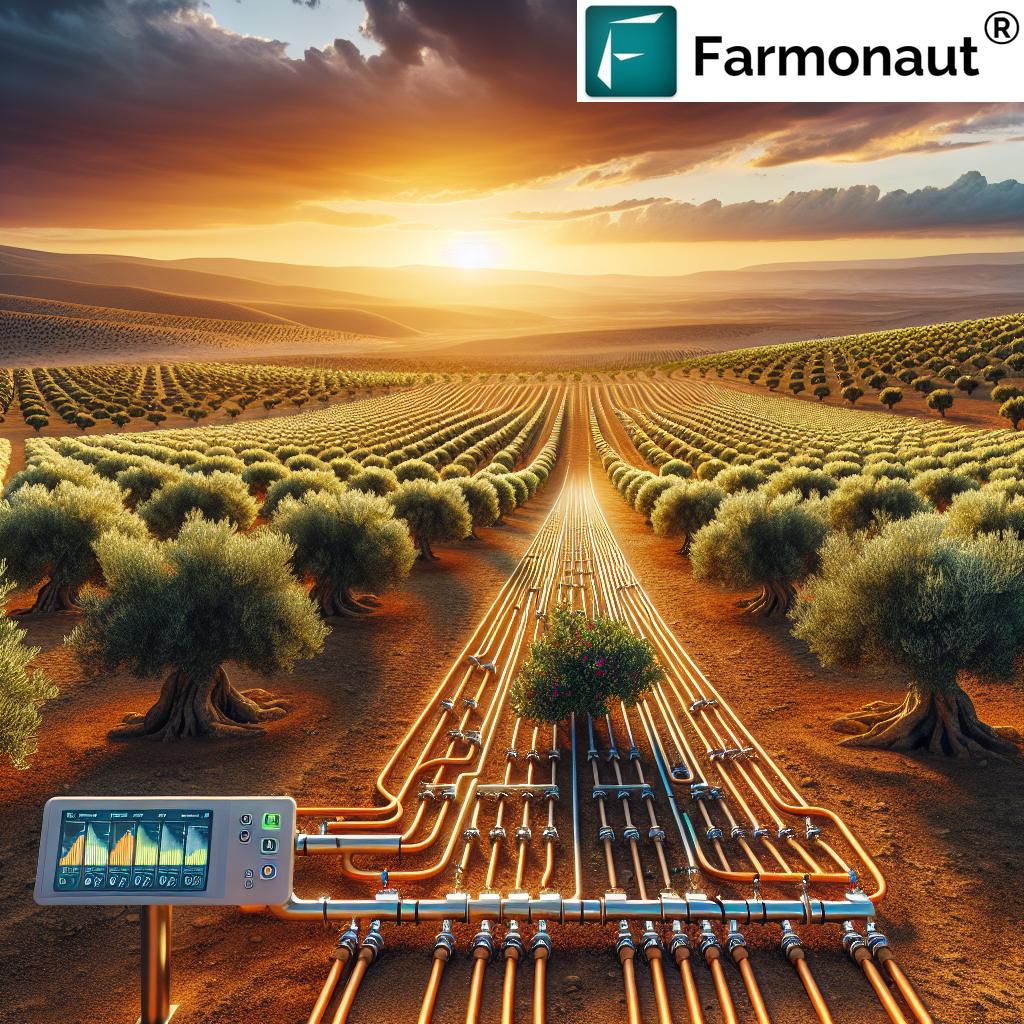Responsible Water Use in Agriculture Kenya: 5 Key Practices for 2025 & Beyond
“Kenyan farmers using efficient irrigation can reduce water usage by up to 50% compared to traditional methods.”
Table of Contents
- Introduction: Why Responsible Water Use in Agriculture Kenya Matters
- The Water Scarcity Challenge in Kenyan Agriculture
- Key Principles of Responsible Water Management
- 1. Efficient Irrigation Techniques: The Foundation of Responsible Farming Practices
- 2. Rainwater Harvesting and Smart Water Storage
- 3. Crop and Livestock Water Management
- 4. Soil Moisture Conservation: Maximizing Every Drop
- 5. Community-Based Water Governance and Responsible Forestry Practices
- Key Water-Saving Practices in Kenyan Agriculture (Comparative Table)
- Leveraging Technology: How Farmonaut Supports Responsible Water Use
- The Road Ahead: Policy, Development and the 2025 Outlook
- Frequently Asked Questions
- Conclusion: Committing to Responsible Water Use in Kenyan Agriculture
Introduction: Why Responsible Water Use in Agriculture Kenya Matters
Water is the lifeblood of agriculture, especially in Kenya, a country where farming forms the backbone of the economy, supports over 70% of livelihoods, and provides food security for millions. However, the availability of water is under increasing strain due to climate change, population growth, land degradation, and inefficient management. As we approach 2025, adopting responsible water use in agriculture Kenya becomes an urgent priority—to ensure food security, support sustainable development, and protect vital ecosystems.
In this comprehensive guide, we explore five key practices at the heart of responsible farming practices for water conservation in Kenya, explain why each is critical, and how integrating modern technologies—such as those offered by Farmonaut—can help Kenyan farmers thrive amidst uncertainty.
The Water Scarcity Challenge in Kenyan Agriculture
Few issues are as pressing for Kenyans as the enduring challenge of water scarcity. The country’s variable rainfall, recurrent droughts, and overreliance on inefficient irrigation systems greatly exacerbate the problem. Agriculture in Kenya accounts for approximately 70-80% of total water consumption, with much of it lost through evaporation, runoff, or other inefficient methods.
These inefficiencies in water management not only reduce farm productivity and threaten food security, but also endanger the very water sources that support communities and ecosystems. Consequently, responsible water use in agriculture Kenya is no longer an option but an urgent necessity.
- Rainfall patterns are becoming increasingly unpredictable due to climate change.
- Rapid population growth in Kenya amplifies the demand for water, food, and livelihoods.
- Land degradation from deforestation, unsustainable irrigation, and overgrazing further strains the water cycle.
- Traditional irrigation techniques waste a significant portion of available water.
Key Principles of Responsible Water Management
To address water scarcity and secure a sustainable future for Kenyan agriculture, we must embrace a set of fundamental principles. These underpin all successful responsible farming practices and ensure that our approaches are both practical and scalable across diverse Kenyan communities and farm sizes.
- Efficiency: Maximize the benefit from each drop of water—especially in irrigation—through advanced technologies and improved techniques.
- Conservation: Protect water resources by minimizing losses, reusing water where possible, and maintaining soil structure to improve retention.
- Sustainability: Balance farmland productivity with the needs of local ecosystems and future generations by avoiding overuse and pollution.
- Inclusivity: Foster community-based decision-making and access for all stakeholders, strengthening water governance at every level.
- Resilience: Build adaptation to climate variability into every stage of farm water management.
1. Efficient Irrigation Techniques: The Foundation of Responsible Farming Practices
Why Move Beyond Traditional Methods?
Traditional surface irrigation—where water is spread across fields via furrows or flooding—is widespread in Kenya but is often highly wasteful. The inefficiency arises because large volumes of water are lost to evaporation, deep percolation, and runoff.
Switching to more efficient irrigation techniques can reduce water use by up to 50% on Kenyan farms, making this practice essential for both food security and environmental conservation.
- Drip irrigation delivers water directly to the roots of each plant, cutting losses to evaporation and runoff. It’s excellent for vegetables, fruit trees, and high-value crops.
- Sprinkler systems mimic rainfall by spraying water over crops using pipes and rotating nozzles. They allow for precise water delivery and are suitable for grains and pastures.
- Soil moisture monitoring tools and sensors help determine exactly when to irrigate, eliminating unnecessary watering.
- The Kenya Agricultural and Livestock Research Organization (KALRO) is actively working to promote affordable, scalable irrigation systems for smallholder farmers.
-
Benefit: Efficient irrigation reduces both water usage and energy costs, while boosting crop yields—a crucial factor as climate stress intensifies.
Tip: Pairing modern irrigation with mobile or remote sensing tools (like Farmonaut) ensures optimal scheduling, preventing both under- and over-watering. Explore Farmonaut’s API to learn how data integration can drive precise water management and boost sustainability.
2. Rainwater Harvesting and Smart Water Storage
“Rainwater harvesting in Kenyan agriculture can supply up to 30% of a farm’s annual water needs.”
Rainwater harvesting is a time-tested method that is gaining momentum in Kenya as a way to supplement water sources and adapt to variable rainfall. By capturing and storing rainfall during the wet season, farmers can build up a reserve to use during dry spells—boosting resilience while reducing dependency on fragile underground water supplies and rivers.
- Rooftop rainwater collection tanks, farm ponds, and check dams are practical and cost-effective solutions appropriate for both smallholders and larger operations.
- Simple gravity-fed drip irrigation systems can be connected to storage tanks for efficient water use even in areas lacking reliable electricity.
- Rainwater harvesting also reduces surface runoff, minimizing soil erosion and fertilizer loss.
Systems can be established using locally available materials, making them accessible and affordable, with maintenance tailored to community resources. Smart water storage systems further enable responsible water management by ensuring water is always available for crops and livestock during critical periods.
- Environmental benefit: Less runoff also means less sediment and chemical pollution reaching local rivers and wetlands, helping protect water quality and nearby ecosystems.
- Smart tip: Digital apps and remote monitoring (see Farmonaut’s large-scale farm management tools) can track tank levels, water quality, and weather forecasts to improve water storage strategies.
Harvested rainwater can also be used in tandem with micro-irrigation or to supplement livestock needs in responsible dairy farming operations, further broadening water savings across the farm ecosystem.
Explore: Detailed technical guidelines and monitoring support can be adopted from the Farmonaut Fleet & Resource Management solution—helping track water deliveries, tank refills, and logistical planning for rainwater-dependent operations.
3. Crop and Livestock Water Management: Matching Water to Actual Needs
Responsible water use in agriculture Kenya means aligning every drop to actual crop and animal requirements—neither over- nor under-supplying at any stage. This begins with crop selection and carries through to final harvest and livestock management.
- Selecting drought-tolerant crop varieties is essential. These crops are bred to thrive with less water and under more unpredictable rainfall, safeguarding food production even during dry spells.
- Staggered or optimized planting calendars allow crops to make the best use of anticipated rainfall and minimize water stress periods.
-
For responsible dairy farming and other livestock systems, water use efficiency matters in:
- Animal drinking needs
- Cleaning (minimal, targeted washing—avoid excessive hosing down of barns)
- Watering of fodder and pastures—use drip systems where feasible
- Preventing contamination of local streams and groundwater by managing wastewater responsibly
- Rotational grazing and strategically placed watering points save water and reduce overgrazing or land degradation.
Fact: Managing livestock’s water needs with precision enhances animal health, improves productivity, and reduces disease risk—all while safeguarding the water sources downstream.
-
Technology boost:
Farmonaut’s real-time advisory systems and AI-based weather forecasting tools
(details at Farmonaut Crop Plantation & Forest Advisory) equip Kenyan farmers with the information needed to match field activities to rainfall, optimize scheduling, and reduce overwatering.
For full traceability from crop to livestock product, secure your supply chain integrity with Farmonaut’s blockchain-based agricultural traceability solutions, ensuring both resource use transparency and consumer trust.
4. Soil Moisture Conservation: Maximizing Every Drop
Soil health directly affects water retention and usage—good soils hold water better, support healthy crops, and reduce the need for frequent irrigation. Responsible farming practices that conserve soil moisture are critical for water management in Kenyan agriculture.
- Mulching: Placing organic matter (straw, crop residues, grass) on soil’s surface reduces evaporation, suppresses weeds, and stabilizes soil temperature.
- Minimum or no-tillage: By disturbing the soil less, moisture is held within, and beneficial soil organisms thrive, which also reduces erosion.
- Agroforestry: Integrating trees into farm landscapes provides shade, reduces wind speed (slowing evaporation), and supports groundwater recharge—key principles at the heart of the center for responsible forestry and responsible forestry practices.
- Cover cropping: Planting legumes or grasses between main cropping cycles adds organic matter, shields the soil, and breaks water runoff speed.
Key outcome:
Conserving soil moisture with these practices sharply reduces overall water consumption, boosts the effectiveness of limited irrigation, and makes crops more resilient to droughts and climate change.
Did you know? AI and satellite monitoring tools, such as those available via Farmonaut’s Agro Admin platform, enable large and small farmers alike to track real-time soil moisture, crop stress, and water use patterns, empowering precise intervention and resource conservation.
5. Community-Based Water Governance & Responsible Forestry Practices
The sustainability of water resources in Kenya depends not only on individual farmers’ actions but equally on fair community management and the wider preservation of Kenyan landscapes through responsible forestry practices.
Community Water Governance
- Water user associations (WUAs): Locally-driven organizations can coordinate water allocation, resolve disputes, maintain infrastructure, and enforce sustainable withdrawal quotas, benefiting both farmers and downstream communities.
- Participatory decision-making: Ensures all users (smallholders, large farms, pastoralists, women’s groups) have a voice in how water is shared and protected.
- Access to climate and water data: Community institutions equipped with weather forecasts, river level sensors, and satellite imagery can plan for drought and adaptation, reducing shock impacts.
For more about digital tools enabling accountable water governance, visit the Farmonaut platform or explore API integration for local institutions: API Developer Docs.
Responsible Forestry: The Center of Landscape Water Stability
- Forests stabilize catchments, prevent soil erosion, and enhance underground water recharge—providing the backbone of sustainable water cycles.
- Agroforestry systems (blending trees with crops/livestock) support shade, microclimates, and diverse habitats, while absorbing carbon—a central goal of Farmonaut’s Carbon Footprint Monitoring services.
- Reforestation and protection of watersheds are critical for the ongoing success of Kenyan agriculture, offering climate regulation, local rainfall enhancement, and cleaner water downstream.
- Institutions like the center for responsible forestry play an essential role in advocacy, education, and technical support for both responsible farming and forestry practices.
Key Water-Saving Practices in Kenyan Agriculture
| Practice | Description | Estimated Water Savings (%) | Environmental Benefits |
|---|---|---|---|
| Drip Irrigation | Delivers water directly to plant roots, reducing evaporation and runoff | 35–50% | Reduced water loss, stronger yields, lower risk of erosion |
| Rainwater Harvesting | Captures and stores rainwater for later use during dry periods | Up to 30% | Lower runoff, better drought resilience, improved soil moisture |
| Mulching | Applies organic cover to soil surface to limit evaporation | 15–25% | Healthier soils, reduced temperatures, increased organic matter |
| Cover Cropping | Grows plants between main crops to protect and enrich the soil | 10–20% | Reduces runoff, boosts fertility, limits erosion |
| Drought-Tolerant Crop Selection | Plants adapted crops needing less water, matched to local conditions | 10–30% | Greater resilience, consistent yields under climate change |
| Responsible Forestry / Agroforestry | Incorporates trees for soil, water, and biodiversity benefits | N/A (Indirect but impactful) | Restores hydrology, prevents erosion, supports rainfall |
Leveraging Technology: How Farmonaut Supports Responsible Water Use in Agriculture Kenya
In an age where data-driven decision making rules sustainable agriculture, technology is key to implementing, scaling, and monitoring responsible water use in agriculture Kenya. This is where Farmonaut stands out.
- Satellite-Based Monitoring: Our platform uses multispectral satellite imagery to accurately monitor crop health, soil moisture, and water stress in real time, helping identify inefficiencies and areas needing intervention.
- AI-Driven Advisory: Farmonaut’s Jeevn AI generates real-time alerts, offers weather forecasts, and delivers tailored irrigation recommendations—so water is applied only when and where needed.
- Environmental Impact Tracking: Our carbon footprinting solutions support the shift to low-emission, water-smart agriculture by providing actionable data on resource use and climate impact.
- Blockchain Traceability: With Farmonaut’s blockchain traceability system, both farmers and consumers can trust the transparency of supply chains—from resource use in the field to end-market delivery.
- Fleet and Resource Management: Our fleet management tools help optimize logistics, monitor water delivery trucks, and ensure equitable resource distribution, reducing wastage.
- Scalability: Farmonaut’s platform supports everyone, from individual smallholders to the Kenyan government, offering affordable, modular technology solutions accessed via apps or APIs.
- Accessibility: Our mission is to make advanced satellite-driven insights affordable and accessible to all users. Kenyan farmers can use Farmonaut via Android, iOS, or Web—see download options here.
- Integration for financial services: Satellite-based verification fuels more reliable crop loan and insurance approvals, giving farmers access to support during dry years or extreme rainfall events.
Affordable subscriptions for farms and agri-businesses:
The Road Ahead: Policy, Development and the 2025 Outlook
For Kenya to transition to sustainable agricultural water management, national policies and collective stakeholder action must reinforce and enable these five key practices.
- Kenyan Government Vision 2030 & National Water Policies: These frameworks prioritize integrated water resource management, bolster water infrastructure, and emphasize conservation to ensure resilient food systems.
- Scaling up interventions: By 2025, expanded access to technological tools (like Farmonaut), coordinated investments, and robust capacity-building for farmers and local institutions will be essential to sustaining water availability.
- Digital transformation: Leveraging digital apps, remote sensing, and blockchain can dramatically improve water monitoring, farmer education, and resource accountability—even in Kenya’s most remote regions.
- Climate-resilience as a guiding principle: All practice adoption—whether in irrigation, forestry, or soil management—must anticipate more intense and frequent droughts, floods, and shifting seasons.
Frequently Asked Questions (FAQ)
What does responsible water use in agriculture Kenya mean?
It means using water efficiently and sustainably in Kenyan farming, combining improved irrigation, rainwater harvesting, soil conservation, and community management so as to support food security, protect the environment, and sustain economic development.
How effective is drip irrigation for Kenyan farmers?
Drip irrigation can reduce water use by up to 50% compared to traditional surface irrigation, by delivering water directly to plant roots and minimizing evaporation.
How can smallholder farmers afford new irrigation systems?
Many organizations in Kenya, including KALRO, are promoting affordable, scalable irrigation technologies. Modern apps and APIs (such as Farmonaut’s solutions) offer cost-effective tools for farm monitoring and management.
Is rainwater harvesting effective for large-scale farming?
Yes! Rainwater harvesting in Kenya can supply up to 30% of annual water needs and is scalable to both small and large agricultural operations. Strategic storage combined with irrigation optimizes its effectiveness even in commercial setups.
What are the environmental benefits of responsible forestry practices in Kenya?
Responsible forestry stabilizes soils, supports healthy watersheds, boosts local rainfall, enhances biodiversity, and improves overall climate resilience for farming communities.
How does technology like Farmonaut support sustainable agriculture?
Farmonaut uses satellite monitoring, AI, and blockchain-based tools to provide real-time insights on water usage, field conditions, carbon footprinting, and supply-chain traceability—empowering farmers and institutions to maximize sustainability, reduce losses, and ensure transparency.
Conclusion: Committing to Responsible Water Use in Kenyan Agriculture
As we navigate the decade to 2025 and beyond, the importance of responsible water use in agriculture Kenya is both urgent and inescapable. The intertwined realities of growing population, uncertain rainfall, climate shocks, and environmental strain demand that we prioritize efficient irrigation, rainwater harvesting, responsible farming practices, soil conservation, community governance, and responsible forestry practices at every level.
By adopting technology, strengthening institutions, and respecting the deep links between forests, water, soil, and food, Kenyan farmers and communities can secure a brighter, more resilient future. It is our collective choice to ensure food security, support economic development, and protect our environment for generations to come.















